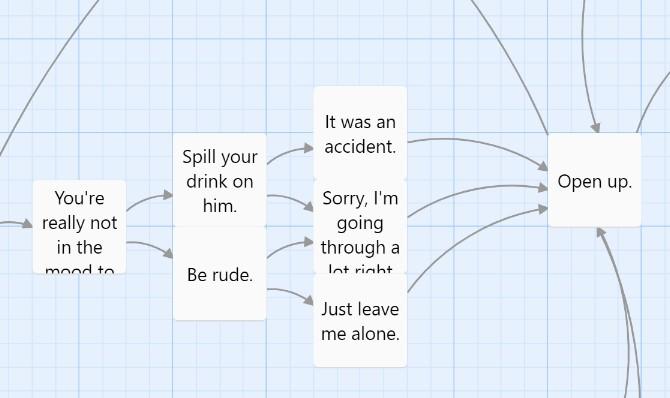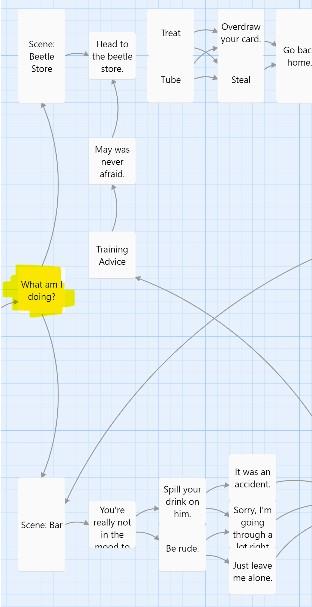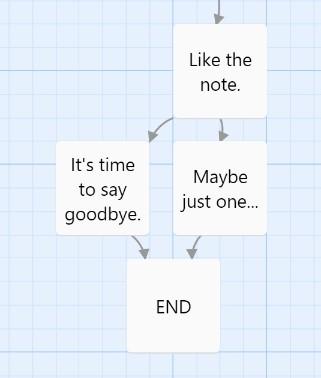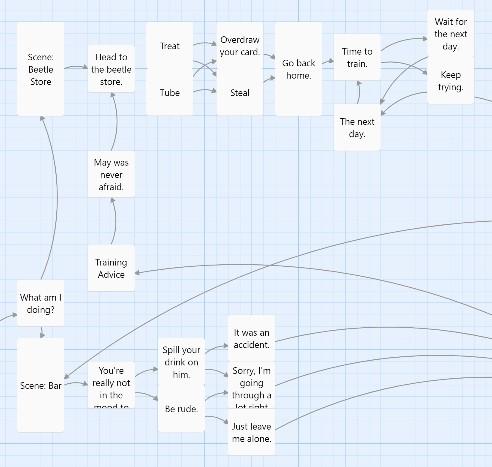Play My Sister’s Beetles before reading further. Password: cs377g
Overview
I made My Sister’s Beetles to explore grief through interactive fiction. In the game, the protagonist tries to become a beetle racer in order to deal with the death of their sister. The goal of the game was to allow players to experience what one process of grieving looks like by acting it out themselves. As the player plays the story, they get to experience the five stages of grief and are forced to act in ways that might seem irrational to an outside observer, but are actually reasonable for a person dealing with loss. By acting out these choices, players hopefully walk away with a greater understanding of friends/coworkers/loved ones who might be dealing with grief and build empathy for the ways they might lash out. Practical examples of how to support someone going through loss are also taught through the protagonist’s relationship with their sister’s old friend.
For this project, I did research into the five stages of grief, and the player acts out each of them at different points in the story. I also researched how to best support someone dealing with grief. I created John as a “role model” character who acts out these support methods—reaching out to the protagonist, asking how they are, and offering to support them practically, all while not making common mistakes like offering unsolicited advice or telling the protagonist how to feel.
Learning Objectives: To build empathy in players for how grieving can look (especially how it can cause someone to act irrationally) and provide a practical model for how to help support others through the grieving process.
Why this premise? My Sister’s Beetles is an embedded narrative game in which the player learns the specifics of the protagonist’s grief gradually as they play through the story. At the outset of the story, the player isn’t aware that the protagonist is dealing with grief—they only see the downstream effects of it (social isolation, apathy, lack of motivation). I structured the game this way because I wanted to give the sense that the protagonist is in denial of their sister’s death, and avoids thinking about it. In the same way, I wanted the hook of the game to be something that is completely unrelated to loss—and then surprise the player with the emotional story that they uncover. Players come in expecting a non-serious beetle story but slowly realize that it is something much deeper. I hope this increases the emotional impact of the story.
Additionally, I wanted to transport players into the shoes of a protagonist whose life they aren’t familiar with at all. Part of the grieving process I wanted to communicate is that it looks different for everyone, and happens in all kinds of contexts. However, I also wanted the premise to be “boring” enough that the player could imagine it happening to them—in other words, I wanted to avoid fantasy or stories about exceptional people. I thought beetle racing balanced the uniqueness with the mundanity.
Meaningful Choices
1. Beetle Race
At the scrimmage, the player has to choose where to place the “treat” and this depends on if they remember information from earlier in the story where they recalled something important May told them. The objective with this choice was to give the player the sense that their relationship with May hangs over their everyday choices and she’s like a “voice in the back of their head.” Some Twine logic tracks whether or not they choose correctly, and it impacts the three stages of the race accordingly.

Twine logic tracks if players correctly heeded May’s advice.
2. Dilemmas
One of the main learning goals for this game was to build empathy in players for how grieving can cause people to act irrationally. Some of the choices in the story present the player with no good options, and this forces the player to act in a way that they normally wouldn’t.
For example, in the conversation with John at the bar, the player has to choose between Be rude and Spill your drink on him.

There’s no good choice.
Of course, the player doesn’t want to do either of these things. But the lesson is that in a grieving state, you don’t act like you normally would.
P.S. John’s response is always understanding, and he encourages the player to open up no matter how they act. This was meant to achieve the other learning goal, which was to give players a model for how to support others going through loss. John leads with empathy and has patience for the player.

3. Training vs. Getting Drunk
The major branching point of the game is after the player fails to make an omelette. They have two choices, to either rededicate themselves to the training regimen or go get drunk. Both lead to pretty different storylines. (See the “key choice” node highlighted to the left).
If you go to the bar, you have a conversation where you lash out at John.
If you go to the store, you steal something or overdraft your card because you’re obsessed with the idea of winning the race as a way to resolve your feelings about May.
The secret here is that no matter what the player does, it doesn’t make them feel any better about their sister. While one seems hopeful (training) and the other like giving up (bar), they’re both coping mechanisms to avoid dealing with the players’ emotions about their sister. In fact, the player’s feelings aren’t resolved until they open up to John sufficiently.
4. Resolution
In the end of the story, the player gets one last key choice: to either keep or give away their beetle companion. I wanted to leave the players with the sense that there is no one “right way” for acceptance to look like. Maybe it’s right to keep the beetle. Maybe it’s best to wash your hands clean of the whole thing.
By giving players agency in this key moment, I wanted to leave players with a feeling of empowerment. Both lead to the player gaining a bit of acceptance about their sister—maybe not all the way, but a step in the right direction.

Right before the end, players get to decide what “acceptance” looks like.
Playtesting
1st Playtest (college-aged female from 377G class, 2/7)
My first playtest was on the first part of the story, from the start through the beetle scrimmage. At the time, the story was about ten “pages” long. Going in, I wanted to test if the premise worked, and if the player got the sense it was an embedded narrative.
Things to keep:
- Player loved she could choose her own beetle
- “Oh, I’m taking the red one, she’s a girl.”
Things to change:
- A bit confused by the starting scene – needs more transporting details
- Got a bit lost when beetles were introduced
- Kind of glossed over the parts about May
- Might have suggested it was a mystery game
- “Ooo… dun dun dun, who is May?”
- Wanted more agency over the outcome of the beetle race
Overall, I decided that the game needed to hint more directly about May–as it was, the suggestions of who she was the how the protagonist feels about them were too subtle. When the player said “Ooo… dun dun dun, who is May?”, I knew I was giving them the wrong signals about May, since they thought she was a spy-type character/the antagonist.
2nd Playtest (college-aged female, not from 377G, 2/9)

After the first playtest, fleshed out the introduction.

However, after the intro, the plot was still very linear at this point.
For the second playtest, I fleshed out the storyline as a linear plot, including the Store and Bar scenes. Not all the scenes were written, but I wanted to test the overall flow of the narrative.
Things to keep:
- Player got the right feeling about May (got the sense this was about grief)
- Liked the garage scene–surprised about beetles, laughed
- Player felt distressed by having to pick between two bad options in the bar
- Liked introduction
Things to change:
- Sister’s room is a bit of a lull in the narrative
- Doesn’t focus on beetles enough?
Debrief
- Felt it was a bit linear (“Which of my choices mattered?”)
Changes to make:
- Need to improve importance of choices (player got a sense they were just reading a story page by page)
- Cut sister’s room scene to focus narrative more on story
3rd and 4th Playtests (college-aged male from 377G and college-aged female not from 377G, 2/15)

After the second playtest, I split the linear narrative into two branching paths (that loop on each other).
I ran two final playtests where the game was close to its finished product.
Notes:
- Characterization of May is still a bit too “lighthearted,” players aren’t quite getting that it’s a game about grief early enough
- Fix: add more serious language when describing May, cut some of the jokes/quips, especially alligator in the garage scene
- Players want some sense of agency at the end
- “Wait, did I get over her or not?”
In this test, I refined some bugs and typos and polished up language to make sure I was hitting an emotionally serious tone. Also, this was where I came up with the idea for “two endings” since players wanted a bit of agency at the end (as it was, the resolution felt like it didn’t let the players make any choices).
Reflection
My Sister’s Beetles was unfamiliar ground for me—it’s the first IF game I’ve made—but through my playtests I was proud to see that some players found it emotionally affecting and walked away with more awareness of what grief can look like, even in lives that seem completely different from ours.
As a game developer, I learned the importance of empowering player choices—in the 2nd playtest, for example, the player was immediately able to sense that they were not “in control” of the story, and this took them completely out of the “magic circle.” Players are very good at feeling intuitively if the world responds to their input, and if they sense something is off, they will complain.
As a fiction writer, I learned the importance of “dilemmas” in the storytelling process. The most gripping parts of the game in my playtesting observations were when the protagonist had “no good choices,” e.g. steal or overdraft your card. Putting players in situations like these might seem like they’d frustrate the player, but actually, players are tenacious and love these moments, because they want to figure out how they’re going to overcome the results of the difficult choice.
If I were to remake My Sister’s Beetles, I wonder if it would’ve been better as a non-embedded narrative game. While I stand by the objective that it creates a stronger emotional impact when the “truth” of the game is revealed, some players found it confusing and thought they were just going to be playing a lighthearted beetle game. Maybe this is an opportunity to simplify the game and let its themes come across stronger.
Thanks for playing! 🪲




My Sister’s Beetle is a really interesting game that explores how one process the loss of a loved one. The main character refused to acknowledge their feelings in the beginning, and slowly opens up to face the truth. It is an incredibly relatable process and also allows me to build empathy with the main character as I observe their action. I had my guess about what happened to the main character’s sister since the very beginning, and I was not really surprised by the story; however, I think that refusal to say what is going on is also very characteristic of someone who is processing grief.
Using Twine to give me choices on the main character’s action also helps making them relatable. Unlike some other stories which I wish there are more endings, I actually appreciate that there is one ending here. This gives me a sense that one can get through their grief and towards acceptance.
I really enjoyed the story and I feel like I went through a healing journey with the main character. If there is anything I want to change, I think I would give some options where the main character has different temperament since different people process grief a little differently.
The biggest value that I saw in the game was that of ‘recovery’. I liked the fact that the choices you make in this game were actually meaningful. I think in terms of the planning and the two starkly different actions you could take (go to a bar vs. keep training the beetle) seemed to be well thought out and planned.
I thought the IF was very engaging because the topic is something that a lot of people can empathise with. The writing style was also very good, and I don’t think the story would have worked on the same topic with an implementation was not as good as this. The medium really fit the story in the sense that it was definitely different from a single-plotline fiction. Maybe it was the reality of it that created this feeling. I did not stop and think during this IF, but it was only because I knew how I would have acted in real life due to going through something similar.
Actually, the biggest thing that I enjoyed about this was the theme. It was so thoughtful to talk about the concept of grief through such an unusual and interesting topic as beetle racing.
The circular loop was, although intended, was frustrating at first, and there could be more explanations about this.